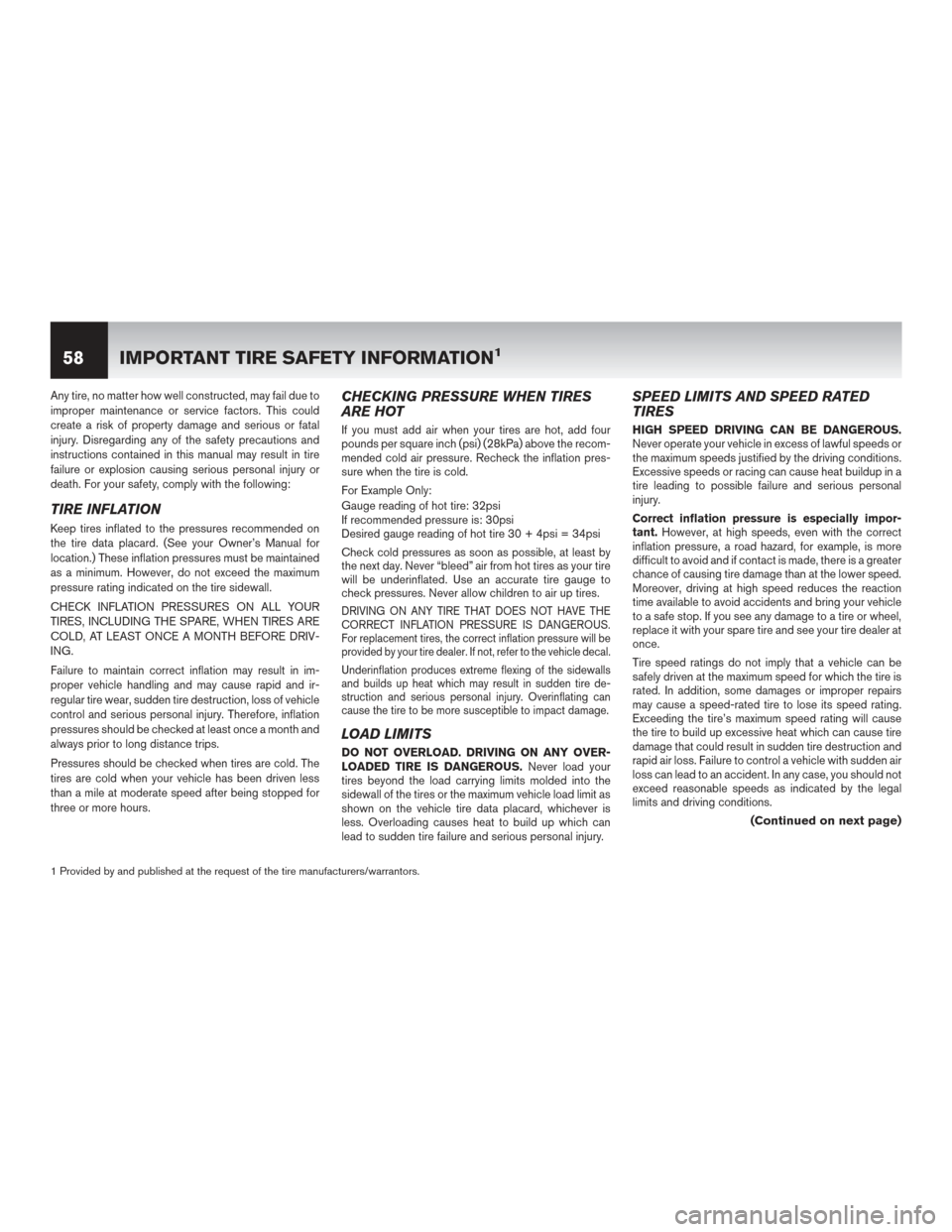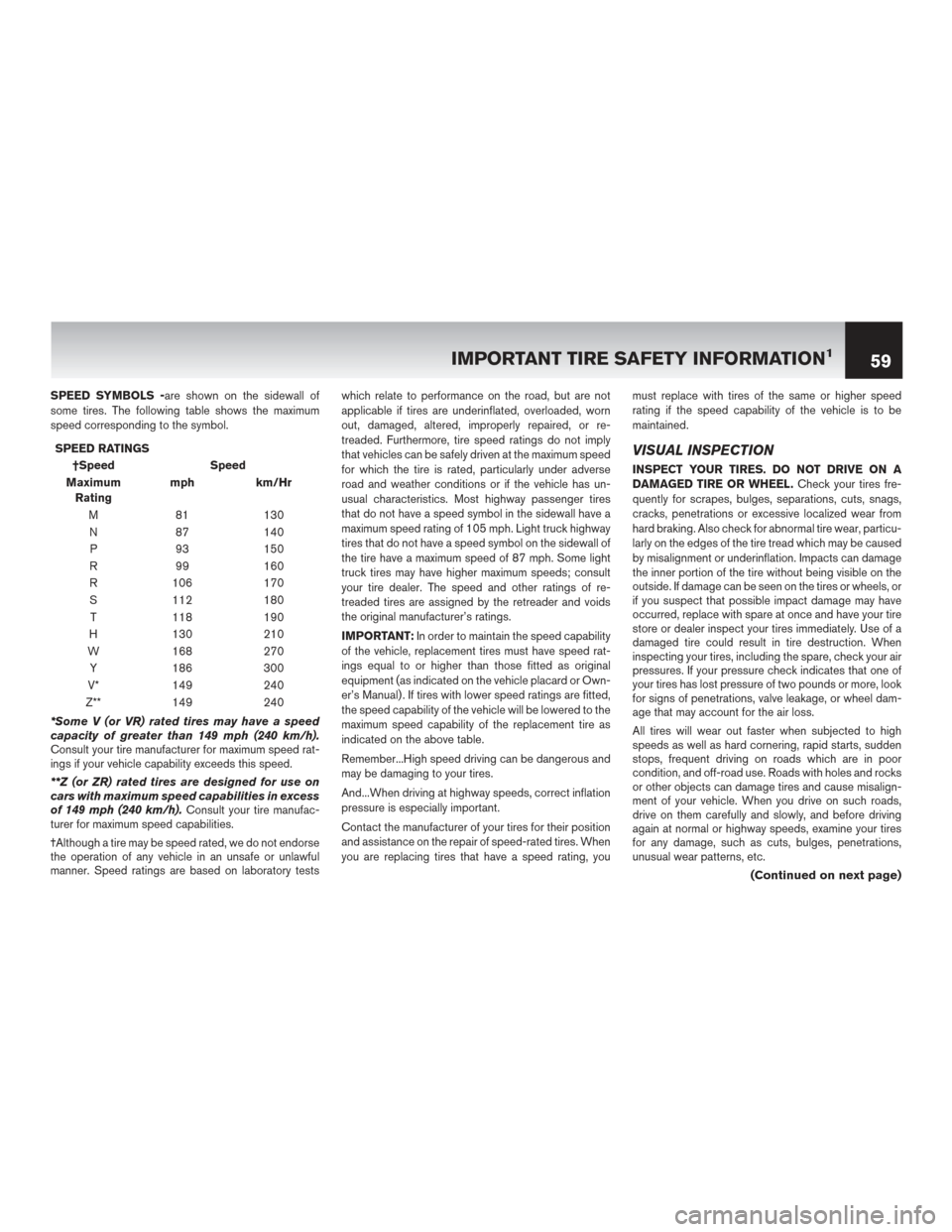2017 NISSAN MAXIMA inflation pressure
[x] Cancel search: inflation pressurePage 63 of 82

Any tire, no matter how well constructed, may fail due to
improper maintenance or service factors. This could
create a risk of property damage and serious or fatal
injury. Disregarding any of the safety precautions and
instructions contained in this manual may result in tire
failure or explosion causing serious personal injury or
death. For your safety, comply with the following:
TIRE INFLATION
Keep tires inflated to the pressures recommended on
the tire data placard. (See your Owner’s Manual for
location.) These inflation pressures must be maintained
as a minimum. However, do not exceed the maximum
pressure rating indicated on the tire sidewall.
CHECK INFLATION PRESSURES ON ALL YOUR
TIRES, INCLUDING THE SPARE, WHEN TIRES ARE
COLD, AT LEAST ONCE A MONTH BEFORE DRIV-
ING.
Failure to maintain correct inflation may result in im-
proper vehicle handling and may cause rapid and ir-
regular tire wear, sudden tire destruction, loss of vehicle
control and serious personal injury. Therefore, inflation
pressures should be checked at least once a month and
always prior to long distance trips.
Pressures should be checked when tires are cold. The
tires are cold when your vehicle has been driven less
than a mile at moderate speed after being stopped for
three or more hours.
CHECKING PRESSURE WHEN TIRES
ARE HOT
If you must add air when your tires are hot, add four
pounds per square inch (psi) (28kPa) above the recom-
mended cold air pressure. Recheck the inflation pres-
sure when the tire is cold.
For Example Only:
Gauge reading of hot tire: 32psi
If recommended pressure is: 30psi
Desired gauge reading of hot tire 30 + 4psi = 34psi
Check cold pressures as soon as possible, at least by
the next day. Never “bleed” air from hot tires as your tire
will be underinflated. Use an accurate tire gauge to
check pressures. Never allow children to air up tires.
DRIVING ON ANY TIRE THAT DOES NOT HAVE THE
CORRECT INFLATION PRESSURE IS DANGEROUS.
For replacement tires, the correct inflation pressure will be
provided by your tire dealer. If not, refer to the vehicle decal.
Underinflation produces extreme flexing of the sidewalls
and builds up heat which may result in sudden tire de-
struction and serious personal injury. Overinflating can
cause the tire to be more susceptible to impact damage.
LOAD LIMITS
DO NOT OVERLOAD. DRIVING ON ANY OVER-
LOADED TIRE IS DANGEROUS.Never load your
tires beyond the load carrying limits molded into the
sidewall of the tires or the maximum vehicle load limit as
shown on the vehicle tire data placard, whichever is
less. Overloading causes heat to build up which can
lead to sudden tire failure and serious personal injury.
SPEED LIMITS AND SPEED RATED
TIRES
HIGH SPEED DRIVING CAN BE DANGEROUS.
Never operate your vehicle in excess of lawful speeds or
the maximum speeds justified by the driving conditions.
Excessive speeds or racing can cause heat buildup in a
tire leading to possible failure and serious personal
injury.
Correct inflation pressure is especially impor-
tant. However, at high speeds, even with the correct
inflation pressure, a road hazard, for example, is more
difficult to avoid and if contact is made, there is a greater
chance of causing tire damage than at the lower speed.
Moreover, driving at high speed reduces the reaction
time available to avoid accidents and bring your vehicle
to a safe stop. If you see any damage to a tire or wheel,
replace it with your spare tire and see your tire dealer at
once.
Tire speed ratings do not imply that a vehicle can be
safely driven at the maximum speed for which the tire is
rated. In addition, some damages or improper repairs
may cause a speed-rated tire to lose its speed rating.
Exceeding the tire’s maximum speed rating will cause
the tire to build up excessive heat which can cause tire
damage that could result in sudden tire destruction and
rapid air loss. Failure to control a vehicle with sudden air
loss can lead to an accident. In any case, you should not
exceed reasonable speeds as indicated by the legal
limits and driving conditions.
(Continued on next page)
1 Provided by and published at the request of the tire manufacturers/warrantors.
58 IMPORTANT TIRE SAFETY INFORMATION1
Page 64 of 82

SPEED SYMBOLS -are shown on the sidewall of
some tires. The following table shows the maximum
speed corresponding to the symbol.SPEED RATINGS †Speed Speed
Maximum Rating mph km/Hr
M 81 130
N 87 140
P 93 150
R 99 160
R 106 170
S 112 180
T 118 190
H 130 210
W 168 270
Y 186 300
V* 149 240
Z** 149 240
*Some V (or VR) rated tires may have a speed
capacity of greater than 149 mph (240 km/h).
Consult your tire manufacturer for maximum speed rat-
ings if your vehicle capability exceeds this speed.
**Z (or ZR) rated tires are designed for use on
cars with maximum speed capabilities in excess
of 149 mph (240 km/h). Consult your tire manufac-
turer for maximum speed capabilities.
†Although a tire may be speed rated, we do not endorse
the operation of any vehicle in an unsafe or unlawful
manner. Speed ratings are based on laboratory tests which relate to performance on the road, but are not
applicable if tires are underinflated, overloaded, worn
out, damaged, altered, improperly repaired, or re-
treaded. Furthermore, tire speed ratings do not imply
that vehicles can be safely driven at the maximum speed
for which the tire is rated, particularly under adverse
road and weather conditions or if the vehicle has un-
usual characteristics. Most highway passenger tires
that do not have a speed symbol in the sidewall have a
maximum speed rating of 105 mph. Light truck highway
tires that do not have a speed symbol on the sidewall of
the tire have a maximum speed of 87 mph. Some light
truck tires may have higher maximum speeds; consult
your tire dealer. The speed and other ratings of re-
treaded tires are assigned by the retreader and voids
the original manufacturer’s ratings.
IMPORTANT:
In order to maintain the speed capability
of the vehicle, replacement tires must have speed rat-
ings equal to or higher than those fitted as original
equipment (as indicated on the vehicle placard or Own-
er’s Manual) . If tires with lower speed ratings are fitted,
the speed capability of the vehicle will be lowered to the
maximum speed capability of the replacement tire as
indicated on the above table.
Remember...High speed driving can be dangerous and
may be damaging to your tires.
And...When driving at highway speeds, correct inflation
pressure is especially important.
Contact the manufacturer of your tires for their position
and assistance on the repair of speed-rated tires. When
you are replacing tires that have a speed rating, you must replace with tires of the same or higher speed
rating if the speed capability of the vehicle is to be
maintained.
VISUAL INSPECTION
INSPECT YOUR TIRES. DO NOT DRIVE ON A
DAMAGED TIRE OR WHEEL.
Check your tires fre-
quently for scrapes, bulges, separations, cuts, snags,
cracks, penetrations or excessive localized wear from
hard braking. Also check for abnormal tire wear, particu-
larly on the edges of the tire tread which may be caused
by misalignment or underinflation. Impacts can damage
the inner portion of the tire without being visible on the
outside. If damage can be seen on the tires or wheels, or
if you suspect that possible impact damage may have
occurred, replace with spare at once and have your tire
store or dealer inspect your tires immediately. Use of a
damaged tire could result in tire destruction. When
inspecting your tires, including the spare, check your air
pressures. If your pressure check indicates that one of
your tires has lost pressure of two pounds or more, look
for signs of penetrations, valve leakage, or wheel dam-
age that may account for the air loss.
All tires will wear out faster when subjected to high
speeds as well as hard cornering, rapid starts, sudden
stops, frequent driving on roads which are in poor
condition, and off-road use. Roads with holes and rocks
or other objects can damage tires and cause misalign-
ment of your vehicle. When you drive on such roads,
drive on them carefully and slowly, and before driving
again at normal or highway speeds, examine your tires
for any damage, such as cuts, bulges, penetrations,
unusual wear patterns, etc.
(Continued on next page)
IMPORTANT TIRE SAFETY INFORMATION159
Page 67 of 82

REPLACING TWO TIRES
If your vehicle was originally equipped with four tires that
were the same size and you are only replacing two of the
four tires, install the new tires on the rear axle. Placing
new tires on the front axle may cause loss of vehicle
control in some driving conditions and cause an acci-
dent and personal injury.
TRAILER TOWING
If you anticipate towing a trailer, you should see a tire
dealer for advice concerning the correct size of tire and
pressure. Tire size and pressure will depend on the type
and size of the trailer and hitch utilized, but in no case
must the maximum cold inflation pressure or the tire load
rating be exceeded. Check the tire decal and your
Owner’s Manual for further recommendations on trailer
towing.
TIRE ALTERATIONS
Do not perform any alterations on your tires. Alterations
may prevent proper performance, leading to tire dam-
age, which can result in an accident. Tires which be-
come unserviceable due to alterations such as truing,
whitewall inlays, addition of balancing or sealant liquids,
may be excluded from warranty coverage. Consult your
tire warranty.
HIGH PRESSURE TEMPORARY SPARE
TIRES
1) The high-pressure spare tire in your Nissanvehicle is designed for temporary use only and
must not be used continually as a regular tire.
The standard tire should be repaired and/or
replaced as soon as possible.
2) Avoid driving over obstacles that may damage the tire through impact or cutting, such as
potholes, glass, metal, etc.
3) Speed must not exceed 50MPH (80km/h) for non-speed-rated temporary spare tires.
4) Temporary spare tires have a limited treadlife which can vary depending on road conditions
and your driving habits. The spare tire should
be returned to the trunk as soon as the stan-
dard tire can be repaired or replaced.
5) Because the high-pressure spare tire was spe- cifically designed for your car, it should not be
used on any other vehicle.
6) Do not use snow chains on your high-pressure spare. This could cause damage to your
vehicle.
7) Check the tire’s cold inflation pressure monthly and maintain at 60psi (4.2kg/cm2) even when
not in use. 8) The high-pressure spare tire should not be
used with any other rim nor should standard
tires, wheel covers, or trim rings be used on
the high-pressure spare tire rim which was
originally installed.
9) When the tread wear indicator appears on the tire, replace it only with the same type spare
tire.
10) Do not enter an automatic carwash with a tem- porary spare tire fitted.
11) Do not make a sharp turn or apply the brakes suddenly when driving on a high-pressure tem-
porary spare.
Note: When using any temporary type spare
tire, be sure to follow the vehicle Own-
er’s Manual instructions.
(Continued on next page)
62IMPORTANT TIRE SAFETY INFORMATION1